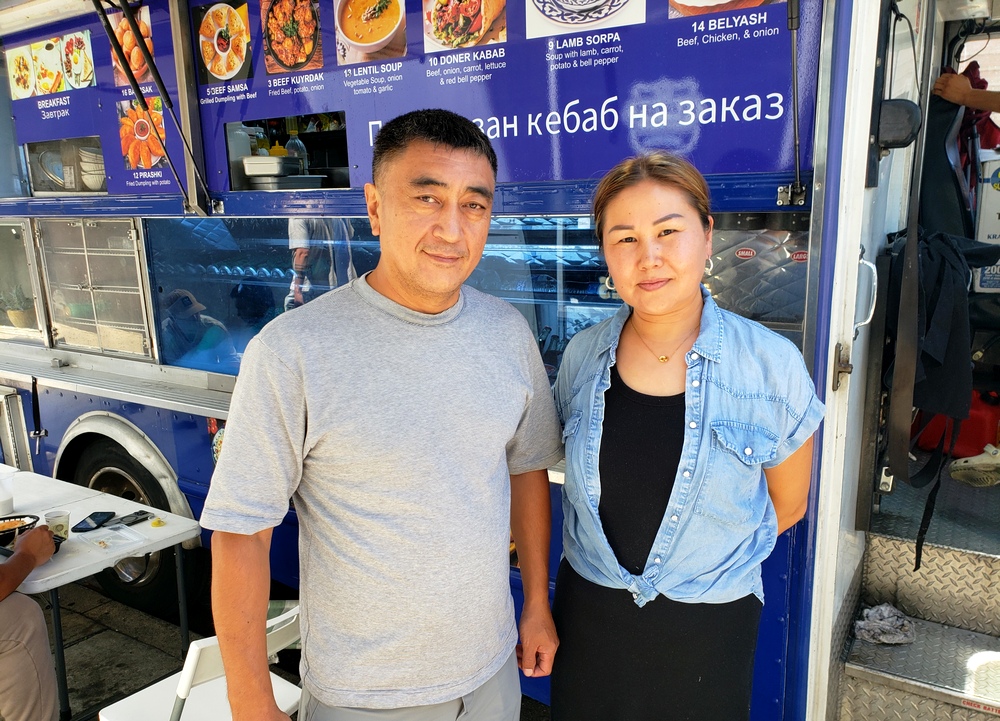On a short block of Butler Avenue, just a few steps north of Santa Monica Boulevard, dueling generators rumble through the day from two new food trucks, parked on opposite sides of the streets, showcasing the cooking and traditions of Central Asia, the vast, mostly landlocked region comprised of Uzbekistan, Kazakhstan, Kyrgyzstan, Turkmenistan, and Tajikistan.
While the Westside’s more hopping blocks of Sawtelle Boulevard reflect the pop-dining trends conquering modern-day Taipei and Tokyo, an ancient cuisine recalling nomads, farmers, Silk Road traders, and horse-backed warriors is reemerging on a small corridor just up the street.
The Central Asian sub-region is a massive expanse, with evidence of human habitation going back at least 45,000 years, criss-crossed and influenced by eons of cultures and histories both heralded and forgotten.
Its primarily Turkic modern-day populations have been significantly changed through millennia of trading, travel, and conquest. Its culture, customs, cuisine, and bloodlines have been heavily impacted over time from the neighboring regions of Iran, Russia, Afghanistan, and western China.
In today’s United States, Chicago is frequently pinpointed as the emergent epicenter of Central Asian migration, where a growing population of both male and female truck drivers from the sub-region, sometimes known collectively as “The ‘Stans,” are concentrated.
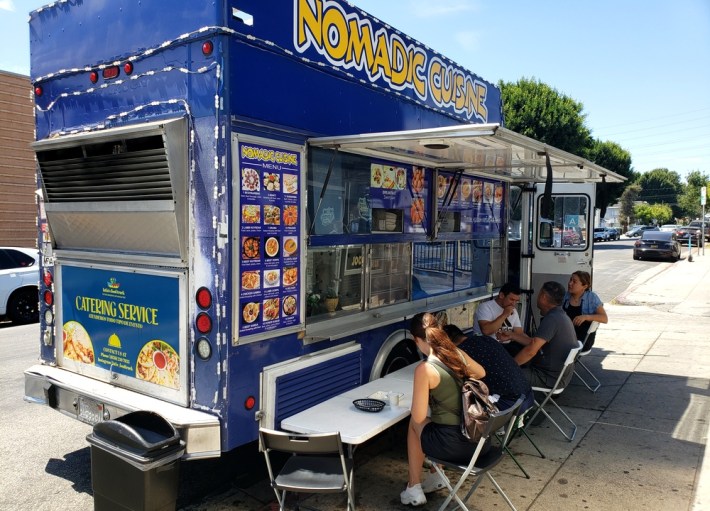
The Central Asian population continues to grow in the U.S., mostly due to Russia’s habit of bulking up its military with migrant men from Kazakhstan and other Central Asian ethnicities, hoping to circumvent domestic criticism towards its war of aggression on Ukraine by whiter, more urban Russian populations.
In West L.A.’s Sawtelle neighborhood, a small community of Central Asian delivery drivers gather every day around The Colony, a ghost kitchen concept on Santa Monica offering eats from an ever-morphing group of food entrepreneurs that includes Trejo’s Tacos, Goop Kitchen, Seoul Mates, and Western Bagel.
These are the Central Asian emigres that the two trucks, Marlen’s Kitchen and Nomadic Cuisine, have set up to offer a taste of Halal home-cooking from the lands they’ve left behind.
Along the way, these businesses are introducing their time-honored dishes to the neighborhood’s diverse community of Oaxaqueños, Persian business owners, college students, and Japanese-Americans whose families carved this community out of beet, barley, and bean farms over a century ago.
Nomadic Cuisine
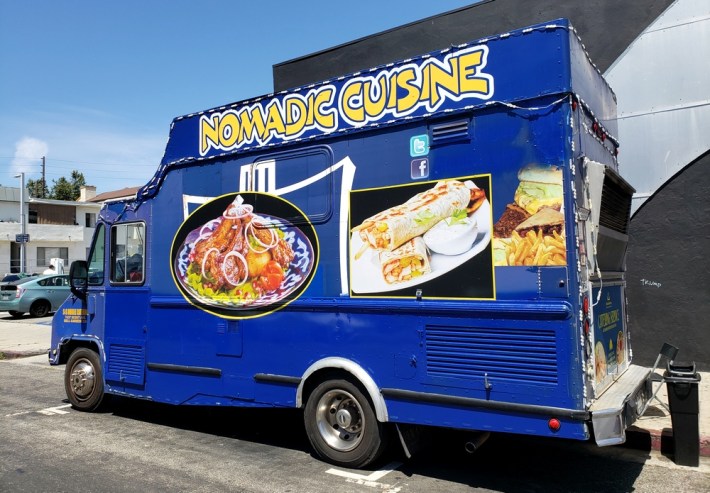
Rakhat and Tolkun Abdurakhmanov researched where to find a Central Asian audience before opening their bright blue L.A. food truck, Nomadic Cuisine.
The couple had recently moved from Irvine, which Rakhat tells us has a bit of a Central Asian community itself. But with no background in formal restaurants, they knew a receptive audience that didn’t need to be educated on their dishes–which are obscure to many in the U.S.–would be critical to their success.
After immigrating from Kyrgyzstan, the couple needed work. Without a command of English, it was hard to find. Food delivery was a natural area to gravitate to, paving the way to their own truck that caters to the Central Asian delivery community while also enlightening people in the U.S. about their traditional dishes.
“We like hospitality and hosting guests a lot in our culture,” Rakhat tells L.A. TACO in Russian, a language once imposed on all citizens of the former Soviet Union. “From an early age we are taught how to set the table, cook all the traditional dishes. I’ve always loved hosting people and cooking for them, so that’s really my background in cooking.”
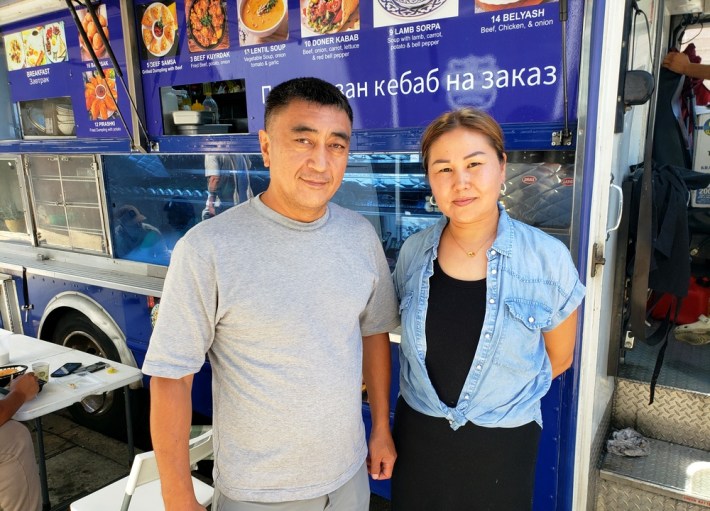
The truck debuted a few months ago with a menu loaded in Central Asian staples. It also serves ramen and breakfast plates, including the two boiled hot dogs with eggs that are familiar to Soviet tables.
At other times of the day, there are the Tatar-style beef-and-chicken pastries known by Russians as belyash; baked samsa recognizable from Xinjiang to Iran; fried beef and lamb versions of Kyrgyz kuyrdak; manti dumplings whose history is as all-encompassing and ancient as the land itself; the national Kazakh dish of beshbarmak; rolled orama dumpling pies; kebabs, shawarma, and naturally, the Central Asian staple of plov (aka “rice pilaf”).
Dishes come and go, sometimes available and sometimes not, depending on the day.
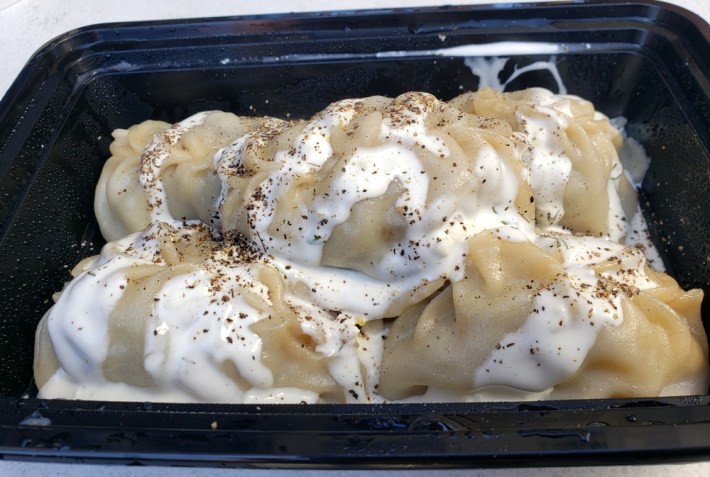
While waiting on our manti, plov, and lamb kuyrdak, Tolkun brings us two cups of hot black tea that he has steeped with lemon and discernible amounts of thyme. Serving tea is traditional in Central Asia, as well as in many former Soviet countries, to help cut the heavy fat in lamb dishes and aid digestion.
Next, a tray of plump manti with seams like bunched fabric are plopped down before us at a plastic folding table pressed against the truck’s open flank. The dumplings resemble a range of snowy, black pepper-speckled mountains running with a lava of yogurt sauce and bursting with juicy beef and White Castle-sized nubs of onion through skins of thin dough.
Tasting fresh and handmade, it’s a struggle to stop scarfing them down. Still, space must be saved for the kuyrdak, a plate of super tender, on-the-bone lamb covered in crescents of white onion and served on top of big, buttery potatoes.
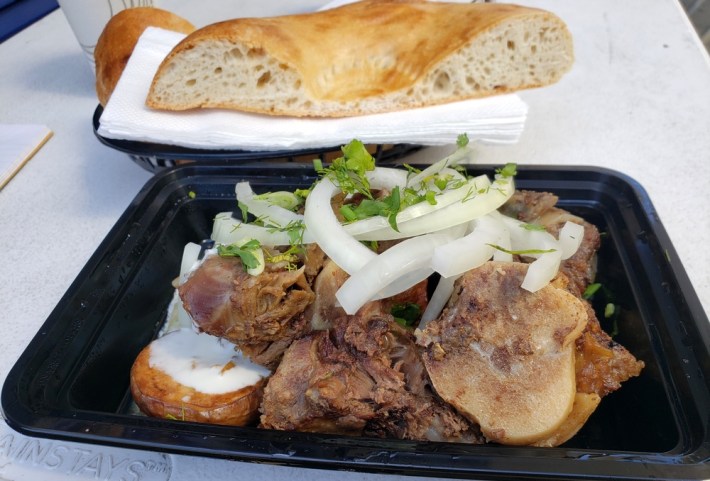
The lamb is unadulterated with spices or herbs, allowing the pure, clean taste of its luscious meat to come front and center. Rakhat tells us the truck goes through one whole lamb every day in its dishes, with kuyrdak being its signature.
“Even people who don’t know the cuisine–like Mexicans and other Americans–now call to see if the lamb kuyrdak is available that day,” Rakhat says of the recipe her mother taught her to make.
Bread is revered, sanctified even, throughout Central Asia, referred to often as the region’s “lifeblood.” Wedges of tandyr nan (aka lepyoshka), the region’s famous circular, stamp-embossed loaves, are served with the kuyrdak, making the ideal sponge for the buttery, fatty oils that pool just below the potatoes.
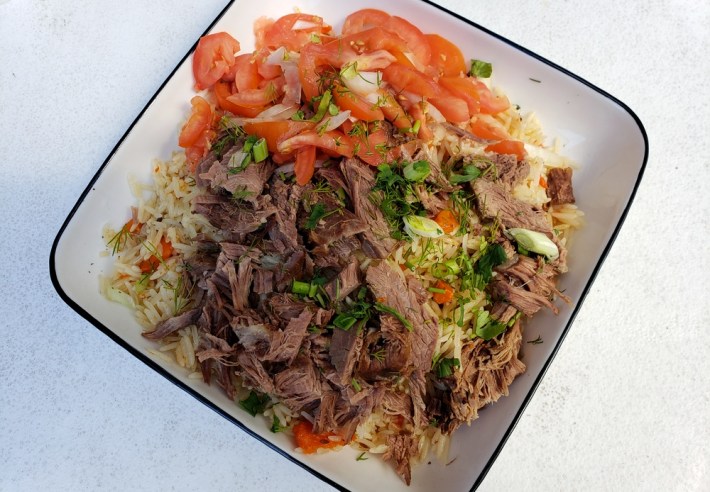
Plov is to Central Asian countries–as well as many other former Soviet states–what the taco is to Los Angeles. Along with kebab, this legendary one-pot meal has survived an untold number of empires past-and-gone to become a near-ubiquitous street food, with huge kazans (cauldrons) of rice, carrots, and meat boiling along the sidewalks of Moscow and in the street markets of Tashkent.
Plov is prepared in a zillion regional and personal recipes across Central Asia, despite its close association with Uzbekistan in so many minds, a connection that stems from a bit of Soviet subterfuge.
Nomadic Cuisine keeps its plov on the simpler end of the spectrum. Rakhat skips the heavy spices found in Uzbek plov for the straightforward flavors found in her fat-coated, long grain basmati rice, white and green onions, and shredded lamb that looks like it was sliced fresh from a shawarma spit. With a simple tomato salad served on the side and occasionally mixing with its plate-mates, the dish bears all the comforts of an honest, home-cooked meal.
Nomadic Cuisine draws a consistent crowd of mesmerizingly beautiful Eurasian faces that reflect the epochs of Central Asia’s multicultural history, digging into filling bowls of rice, shawarma wraps, and impressive lamb shanks while chatting in Russian, their common tongue.
Rakhat is familiar with a lot of the processed and pre-made foods that are popular in the U.S., so she takes pride in cooking every dish here by hand and in her adherence to organic ingredients. The success she and her husband are finding with their truck imbues them with dreams of opening a restaurant of their own someday.
“I’m very proud and honored to represent this cuisine in Los Angeles,” Rakhat says. “I see people come here from early in the morning to late at night. Even when we have to do twice the cooking, I’m happy to see people from outside the community liking the cuisine in L.A.”
Marlen’s Kitchen
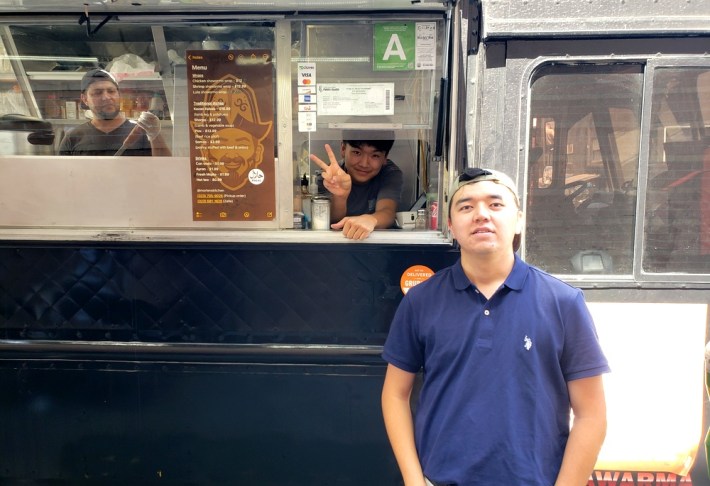
Marlen’s Kitchen has only been open on Sawtelle’s streets for a few weeks. The black truck is still wrapped with the logos of a business called “Shawarma King” as the owners await new signage.
Marlen Baktybek, who came to L.A. from his native Kyrgyzstan two years ago, started as a delivery driver. Noticing the groups of Central Asians idling in the parking lot behind The Colony, he began selling his Central Asian halal cooking to them out of the trunk of his car.
Marlen would offer different dishes, like shorpo and manti, to the drivers every day, despite not knowing how to cook when he first arrived. Using nothing but his Instagram to market the day’s menu, he soon found an audience among his fellow Kyrgyz, as well as local Kazakh, Russian, and Turkish diners, hungry for company and a comforting taste of home.
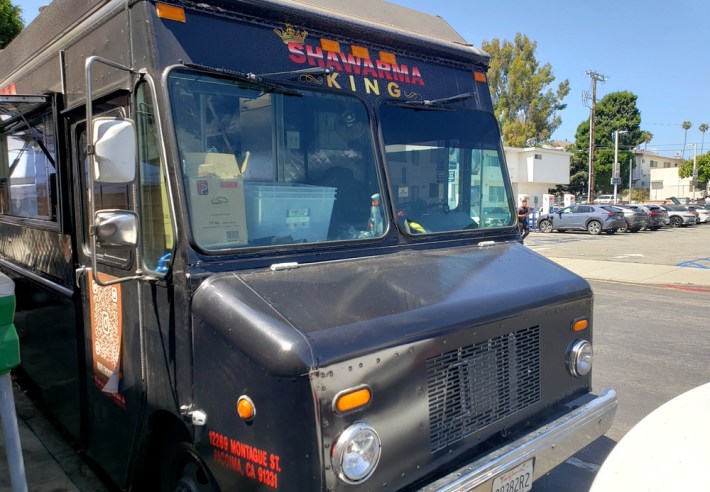
Inspired by his own achievements, as well as the success of L.A.’s Central Asian, halal shawarma truck, Navat, Baktybek expanded by opening Marlen’s Kitchen with two Kyrgyz friends in early July, right across from Nomadic Cuisine. The two trucks split the difference as rivals and compatriots, together forging a Central Asian corridor on this modest West L.A. street.
“We used to get really good orders from The Colony (drivers),” says partner Baku Nariev, a filmmaker who directs the truck’s marketing and social media content. “And we started telling our friends, our brothers, friends. And they called their friends. In this way, we created a community here.”
Nariev notes how the WhatsApp group of this small coterie also rallied to help the delivery drivers avoid parking fines when traffic enforcement increased along the blocks.
“If you are not active on WhatsApp group, you get a ticket,” he says. “It's a real network.”
Marlen’s menu is a little shorter than Nomadic Cuisine’s, leading with wraps of luleh kebab, chicken shawarma, and shrimp shawarma that are more familiar to local eaters outside of Central Asian cultures.
Traditional Central Asian specialties on offer include kazan kebab, nigella seed-pocked samsa, a Tajik take on plov, and shorpo, a derivation of a sort of catchall term for stews, stretching from East Africa to East Asia.
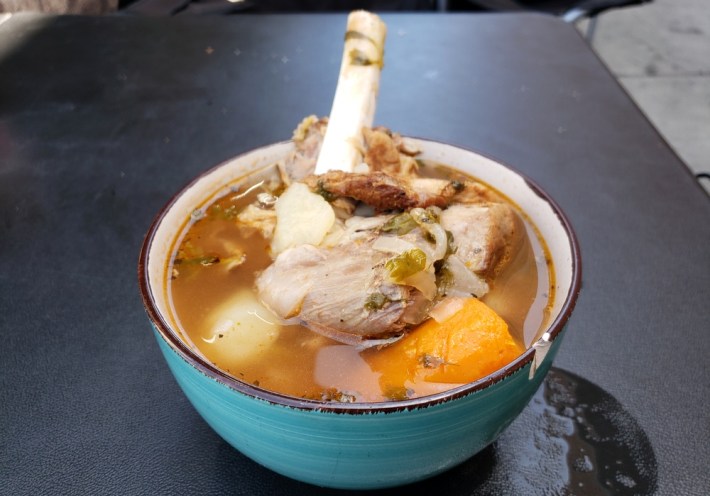
Marlen’s shorpo is served in a customary ceramic piala bowl, near to brimming with a minestrone-like broth and bearing a massive shank of lamb in the middle, bobbing among big chunks of potato, carrot, bell pepper, and onion.
The Aussie lamb is prepared without heavy seasoning, spices, or sauces, sliding off the bone and shredding easily until the bowl fills with broken down shank, its oils ascending to the surface from below, and the rich, straightforward pleasures of the lamb enriching one’s palate.
“When you eat this, when you try this food, you get relaxed, you calm down,” Nariev notes. “It becomes a really good healing food.”
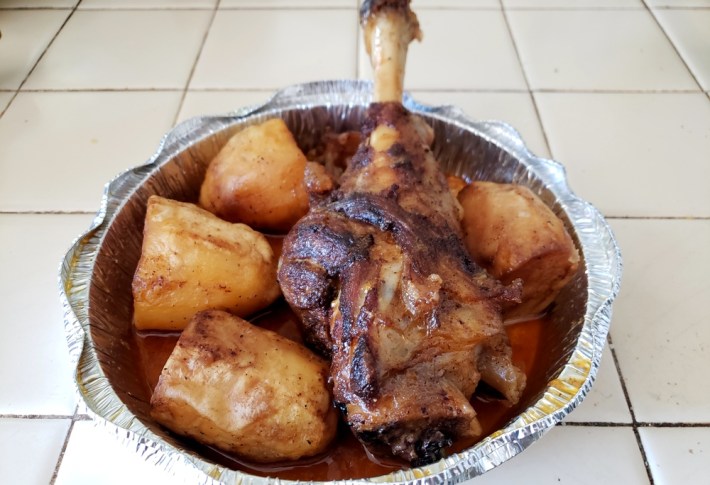
The kazan kebab also centers on a large, super tender lamb shank sitting modestly atop a pile of absolutely irresistible potatoes that soak up liquefied lamb fat and juices.
This is filling cuisine built on the simple, readily available ingredients of the Eurasian Steppes, designed to nourish subsistence farmers, herding nomads, and archaic armies on-the-go. Similar in form to plov, which could technically be made with nothing more than rice, water, fat, and whatever else one happens to have on hand.
Imam, a young man who works on Marlen’s truck, recounts a commonly heard history lesson on plov, telling us that its origins can be traced back to Timur (aka Tamerlane), the 12th century Turco-Mongolian conqueror and emperor who supposedly commissioned this easy-to-make, easy-to-transport dish for his military, in between subduing large swaths of the region and its neighbors.
The apocryphal story sometimes credits other historic vanquishers with plov’s invention, including Alexander the Great some 300 years before the birth of Christ.
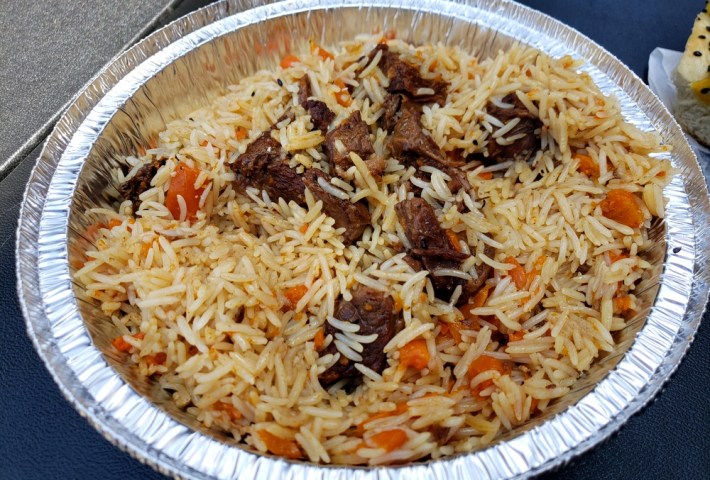
More undeniable is just how satisfying and unique the plov served at Marlen’s happens to be. The chef on board prepares it in a style true to his native Tajikistan, using flax oil instead of the cottonseed oil he used back home.
The fluffy plov, based on parboiled, extra-long-grain basmati rice, has a noticeable sweetness we’ve rarely tasted in a savory plov. It stems from a surfeit of soft carrots sliced long in what we're told is a Tajik and Kyrgyz style.
Every grain of rice comes blissfully coated in fat from the cuts of beef that are fried and boiled for two-to-three hours with onions and carrots, before the yellow-tinged rice is added. An acidic salad of cucumber and tomato is served on the side to slice through all the fat.
These Central Asian trucks both have cooking worth trying and coming back for. Marlen’s side of the street has a slight disadvantage in that parking beside the Bank of America location here is allotted for 15-minute shifts, placing them at the meager mercies of the neighborhood’s meter maids.
Still, Marlen and the crew already have big plans. They hope to someday open restaurants, bakeries, and their own halal meat factory. Currently, the trio of friends enjoys reaching Angelenos of all backgrounds with their Central Asian cooking as they plann their extended empire.
“Every day, we see new people,” Nariev says. “Not only Russian-speaking people. We see also Arab people from Saudi Arabia. And Syrians. We see Black people, white people, Americans, Mexicans. They try our food and they leave good reviews. We get inspired. We love our job. We love our food. If they like our food, we also like these people.”
Nomadic Cuisine ~ 1527 Butler Ave. Los Angeles, CA 90025
Marlen’s Kitchen ~ 11501 Santa Monica Blvd. Los Angeles, CA 90025
